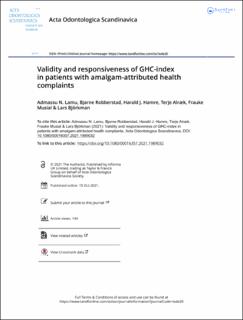| dc.contributor.author | Lamu, Admassu Nadew | |
| dc.contributor.author | Robberstad, Bjarne | |
| dc.contributor.author | Hamre, Harald Johan | |
| dc.contributor.author | Alræk, Terje | |
| dc.contributor.author | Musial, Frauke | |
| dc.contributor.author | Björkman, Lars | |
| dc.date.accessioned | 2021-11-15T13:15:13Z | |
| dc.date.available | 2021-11-15T13:15:13Z | |
| dc.date.created | 2021-11-02T22:12:26Z | |
| dc.date.issued | 2022 | |
| dc.identifier.issn | 0001-6357 | |
| dc.identifier.uri | https://hdl.handle.net/11250/2829608 | |
| dc.description.abstract | Objective: Many patients have medically unexplained physical symptoms (MUPS); some of them attribute their health complaints to dental amalgam fillings. The aim of this study was to assess the validity and responsiveness of General Health Complaints index (GHC-index) for measuring the symptom load in MUPS patients compared to the widely used symptom outcome measure, Giessen Subjective Complaints List (GBB-24).
Methods: Three outcome measures – GHC-index, GBB-24, and Munich Amalgam Scale (MAS) – were administered at baseline and 12 months after removal of all dental amalgam restorations. The validity and responsiveness of these symptom measures were tested against external anchors: bodily distress syndrome (BDS), SF-36 vitality, and visual analogue scale (VAS). We tested both convergent and known group validities. We also examined the predictive validity and responsiveness to changes for each instrument.
Results: All the main outcome measures showed evidence of convergent and known group validities. The GHC-index, GBB-24 and MAS were all able to detect the anticipated differences in BDS and Energy. But the GBB-24 was more efficient in discriminating the BDS compared with the GHC-index (relative efficiency: RE = 0.69; 95% CI: 0.41–0.96) and MAS (RE = 0.59; 95% CI: 0.32–0.86). Each main outcome variable revealed good predictive validity for vitality (standardized coefficient: b ≈ 0.71 and R2 ≈ 0.50). Moderate to high sensitivity to change over time was demonstrated, with GHC-index performing better.
Conclusion: The GHC-index is a valid and responsive instrument for assessing symptom load in MUPS patients attributing their health complaints to amalgam fillings and undergoing amalgam removal. | en_US |
| dc.language.iso | eng | en_US |
| dc.publisher | Taylor and Francis | en_US |
| dc.rights | Navngivelse 4.0 Internasjonal | * |
| dc.rights.uri | http://creativecommons.org/licenses/by/4.0/deed.no | * |
| dc.title | Validity and responsiveness of GHC-index in patients with amalgam-attributed health complaints | en_US |
| dc.type | Journal article | en_US |
| dc.type | Peer reviewed | en_US |
| dc.description.version | publishedVersion | en_US |
| dc.rights.holder | Copyright 2021 The Author(s) | en_US |
| cristin.ispublished | true | |
| cristin.fulltext | original | |
| cristin.qualitycode | 1 | |
| dc.identifier.doi | 10.1080/00016357.2021.1989032 | |
| dc.identifier.cristin | 1950792 | |
| dc.source.journal | Acta Odontologica Scandinavica | en_US |
| dc.source.pagenumber | 226-233 | |
| dc.identifier.citation | Acta Odontologica Scandinavica, 2022, 80 (3), 226-233. | en_US |
| dc.source.volume | 80 | |
| dc.source.issue | 3 | |

